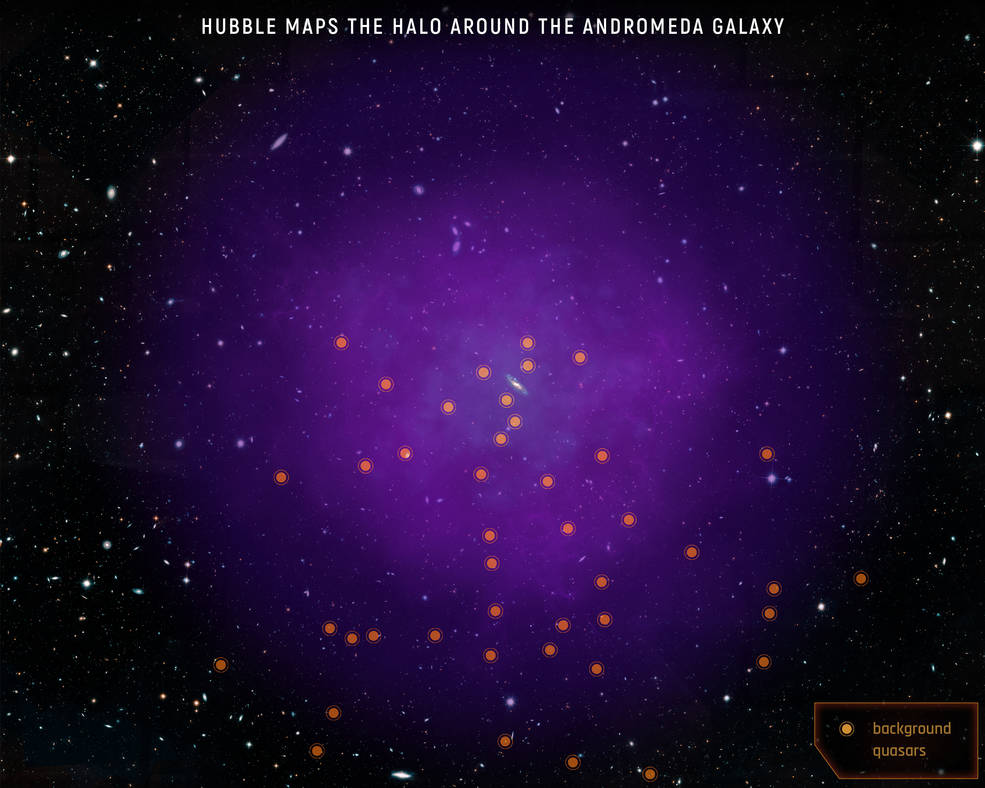That's 1.3 million light-years, and it may go 2 million light-years in some parts, which means Andromeda's halo is already touching our own. The halo has a layered structure, with two main nested and distinct shells of gas. These reservoirs of gas contain fuel for future star formation within the galaxy, as well as outflows from events such as supernovae.
If we could see it, the M31 halo would be about three times the width of the Big Dipper and easily be the biggest feature in the nighttime sky. M31, the Andromeda galaxy, contains as many as 1 trillion stars and is comparable in size to our Milky Way. At a distance of 2.5 million light-years, it is so close to us that the galaxy appears as a cigar-shaped smudge of light high in the autumn sky.

This illustration shows the location of the 43 quasars scientists used to probe Andromeda’s gaseous halo. These quasars—the very distant, brilliant cores of active galaxies powered by black holes—are scattered far behind the halo, allowing scientists to probe multiple regions. Looking through the immense halo at the quasars’ light, the team observed how this light is absorbed by the halo and how that absorption changes in different regions. By tracing the absorption of light coming from the background quasars, scientists are able to probe the halo’s material. Credits: NASA, ESA, and E. Wheatley (STScI)
Because we live inside the Milky Way, we cannot know the signature of our own galaxy's halo but the halos of Andromeda and the Milky Way must be very similar since these two galaxies are quite similar. They are even on a collision course, and will merge to form a giant elliptical galaxy beginning about 4 billion years from now. Their halos are merging even now.
Through a program called Project AMIGA (Absorption Map of Ionized Gas in Andromeda), the study examined the light from 43 quasars--the very distant, brilliant cores of active galaxies powered by black holes--located far beyond Andromeda. The quasars are scattered behind the halo, allowing scientists to probe multiple regions. Looking through the halo at the quasars' light, the team observed how this light is absorbed by the Andromeda halo and how that absorption changes in different regions. The immense Andromeda halo is made of very rarified and ionized gas that doesn't emit radiation that is easily detectable. Therefore, tracing the absorption of light coming from a background source is a better way to probe this material.
The researchers used Hubble's Cosmic Origins Spectrograph (COS) to study the ultraviolet light from the quasars. Ultraviolet light is absorbed by Earth's atmosphere, which makes it impossible to observe with ground-based telescopes. The team used COS to detect ionized gas from carbon, silicon, and oxygen. An atom becomes ionized when radiation strips one or more electrons from it.
Andromeda is the only galaxy in the universe for which this experiment can be done now, and only with Hubble. An ultraviolet-sensitive future space telescope will this type of experiment beyond the approximately 30 galaxies comprising the Local Group.






Comments